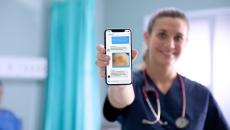Pulse oximeters may be less accurate for Black patients

A fingertip pulse oximeter by Thinkpaul, licensed under CC BY-SA 3.0
A correspondence letter published in the New England Journal of Medicine suggests that pulse oximeters – frequently used in remote patient monitoring – may show misleading readings for Black patients.
Researchers led by Dr. Michael W. Sjoding at the University of Michigan Medical School compared measurements of arterial oxygen saturation with pulse oximetry.
They found that in two large cohorts Black patients had nearly three times the frequency of occult hypoxemia – meaning there was a disconnect between their arterial oxygen saturation and their pulse oximetry – compared to white patients.
"Given the widespread use of pulse oximetry for medical decision making, these findings have some major implications, especially during the current COVID-19 pandemic," wrote the researchers.
WHY IT MATTERS
Pulse oximeters are frequently used in order to triage patients and to monitor individuals with COVID-19, especially as part of a larger remote patient-monitoring ecosystem.
For this study, Sjoding and colleagues analyzed 10,789 pairs of measures of oxygen saturation from 276 Black patients and 1,333 white ones in a cohort from the University of Michigan; and 37,308 pairs obtained from 1,050 Black patients and 7,342 white ones in a multicenter cohort.
In the first cohort, among patients who showed 92-96% oxygen saturation on pulse oximetry, 11.7% of arterial oxygen saturation measurements from Black patients were at less than 88%, compared with 3.6% of white patient measurements.
In the multicenter cohort, 17% of arterial blood gas oxygen saturation measurements among Black patients were at less than 88%, despite saturation measurements of 92-96% on pulse oximeters – compared with 6.2% of measurements among white patients.
"It is important to note that not all Black patients who had a pulse oximetry value of 92 to 96% had occult hypoxemia," wrote the researchers. "However, the variation in risk according to race necessitates the integration of pulse oximetry with other clinical and patient-reported data.”
The NEJM letter did not elaborate as to the manufacturer of the pulse oximeters or whether they were part of a connected device environment. It did note, however, that questions about their technology have been raised in the context of reproducing racial bias.
THE LARGER TREND
The question of addressing bias in the datasets used to train medical devices has arisen multiple times in recent months, with panelists at the HIMSS & Health 2.0 Europe Digital Conference noting that dermatological diagnostic apps trained on mostly white patients could be less accurate among patients with darker skin.
This is of even greater importance amidst the COVID-19 crisis, which has seen stretched-thin hospitals and health systems monitor patients from afar with the help of peripherals such as thermometers and pulse oximeters.
ON THE RECORD
"Oxygen is among the most frequently administered medical therapies, with a level that is commonly adjusted according to the reading on a pulse oximeter that measures patients’ oxygen saturation," wrote the researchers.
"Our results suggest that reliance on pulse oximetry to triage patients and adjust supplemental oxygen levels may place Black patients at increased risk for hypoxemia," they continued.
Kat Jercich is senior editor of Healthcare IT News.
Twitter: @kjercich
Email: kjercich@himss.org
Healthcare IT News is a HIMSS Media publication.
























